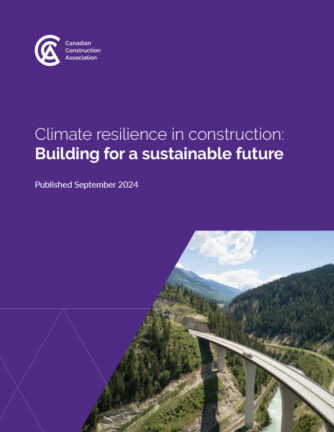
The Canadian Construction Association (CCA) has released a new report that examines the sector’s strides toward sustainability, while outlining the challenges that remain if the industry is to reach its goal of realizing a carbon-neutral built environment.
Titled “Climate resilience in construction: Building for a sustainable future,” the report is written by the association that represents more than 18,000 construction firms in a sector that employs over 1.6 million Canadians and accounts for 7.5 per cent of the country’s gross domestic product. The document builds on a 2021 CCA report that outlined challenges, opportunities and necessary partnerships and policies to reach Canada’s climate goal of achieving net-zero greenhouse gas (GHG) emissions by 2050.
Like many other industries, the national construction community, including the deep foundations sector, is concerned about sustainability. The CCA report emphasizes how Canada’s construction industry is harnessing innovation and technology to minimize its environmental impact. So far, this has included adopting renewable energy practices and green building standards, as well as implementing new technology and using advanced materials.
However, the report also says industry cannot do it alone. The CCA reviews national and international research that highlights a relationship between the level of climate risk and infrastructure decisions.
“As the industry’s national advocate, CCA has also been highlighting the direct linkages between consistent investment by all levels of government in sustainable infrastructure and the resultant decrease in GHG emissions country-wide,” states the report. Simply put, as investments in sustainable building increase, emissions decrease. “Emissions have decreased from 230 tonnes in 2010 to 140.9 tonnes in 2022 per every million dollars invested in infrastructure. This finding is consistent across all provinces,” writes the CCA.
It’s clear that further collaboration and ongoing partnerships with all stakeholders, including every level of government, are required to hasten the transition to a carbon-neutral built environment.
Investing in renewal
Buildings represent almost 40 per cent of global GHG emissions. Given increased extreme climate events, Canada’s soaring population and aging infrastructure, a long-term investment in infrastructure renewal is a priority.
The CCA cites findings from three Canada Infrastructure Report Cards (2012, 2016, 2019), which examined the state of public roads and bridges, culture, recreation and sports facilities, potable water, wastewater, stormwater, public transit and solid waste infrastructure. According to the association, “The key takeaways of that report are that a significant amount of public infrastructure in Canada was aging and in poor condition; reinforcing the urgent need for long-term investments in infrastructure renewal to meet the needs of Canadians….”
The association acknowledges that the Government of Canada has committed tens of billions of dollars to support green infrastructure. It has invested in programs to facilitate the recognition of foreign credentials, including in the construction sector, and created incentives for companies to hire first-year construction apprentices. In addition to these investments, complementary policies include regulations that extend across multiple sectors and levels of government.
Although progress has been made, hurdles still exist. Government partnerships with industry are essential as the construction sector struggles to meet growing infrastructure demands in the face of inadequate funding and planning. The report says the industry needs a roadmap to build a resilient environment that can withstand the challenges of climate change.
Moving forward
The report discusses several ways to improve the climate resiliency of new and existing buildings. Strategies for new buildings include structural changes, planning informed by climate change and enhanced monitoring.
The development of comprehensive strategies for future construction will depend on interdisciplinary collaboration, considering enhancements such as upgraded ventilation, window shades, backwater valves and a strong envelope that resists hotter temperatures, strong winds and excessive precipitation. Retrofits can lead to enhanced energy efficiency in existing buildings. Currently, Canada’s buildings are the third-largest source of GHG emissions in the country.
How can construction companies manage the increased costs associated with sustainability requirements? The CCA calls for new procurement strategies that do not hinge on the lowest bid. Rather, procurement should emphasize productivity, innovation, long-term value and sustainability, alternative delivery models and shared risk. “We also need reliable climate data, updated standards and codes which the industry and suppliers can work toward,” says the association.
Once again, the CCA emphasizes that partnerships are the best way to effect the necessary change. Governments, academia, research institutions and industry all have a role to play in responding to the climate challenges facing the built environment. However, discrepancies exist between federal, provincial and municipal levels of government, and more industry consultation is needed to develop a balanced approach.
The report points to three international jurisdictions (the U.K., Australia and California) that have shown leadership in climate resilience for the built environment. Case studies on each highlight lessons learned and insights that could benefit Canada on its own journey toward resilient building.
In addition, the report makes further recommendations, including the creation of an independent advisory body that would undertake long-term infrastructure planning. It also calls upon government and industry to develop approaches that generate better data, technologies, tools and standards, including the establishment of the Low-Carbon Building Materials Innovation Hub and the National Life-Cycle Inventory Database.
When tendering a bid on a project, it must be clear to industry that climate resilience is a required component. The CCA says that while companies must still compete to deliver the best value on any job, research points to at least 10 per cent in additional costs to ensure resilience. Therefore, expectations must be clearly stated to receive bids that incorporate sustainability planning.
As well, the current model with contractors shouldering the financial risk of building is untenable for future-focused projects, given existing challenges with the supply chain, high interest rates, tight timelines and labour shortages. Speaking of the latter issue, the Canadian construction industry is expected to require 350,000 workers by 2033. Programs that recognize the training and credentials of newcomers to Canada are essential to filling a number of roles, from engineers to construction labourers.
In conclusion, the CCA’s latest report aims to be a catalyst designed to spark a “critical national conversation around ensuring infrastructure resilience in the face of a changing climate.” While the shift towards a resilience-centred procurement process will take time and effort, collaboration between governments, builders, procurement officers and other stakeholders is perhaps the most essential criteria for success.
Read “Climate resilience in construction: Building for a sustainable future” at bit.ly/cca-climate-resilience.
